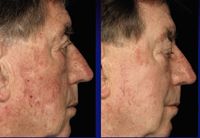- Acne
- Actinic Keratosis
- Aesthetics
- Alopecia
- Atopic Dermatitis
- Buy-and-Bill
- COVID-19
- Case-Based Roundtable
- Chronic Hand Eczema
- Chronic Spontaneous Urticaria
- Drug Watch
- Eczema
- General Dermatology
- Hidradenitis Suppurativa
- Melasma
- NP and PA
- Pediatric Dermatology
- Pigmentary Disorders
- Practice Management
- Precision Medicine and Biologics
- Prurigo Nodularis
- Psoriasis
- Psoriatic Arthritis
- Rare Disease
- Rosacea
- Skin Cancer
- Vitiligo
- Wound Care
Article
Novel nonablative fractional laser shows promise for clearing actinic keratoses
Nonablative fractional resurfacing with a 1,927 nm thulium laser (Fraxel re:store Dual System, Solta Medical) is showing promise for offering a well-tolerated, safe and effective treatment for multiple facial actinic keratoses (AKs), according to the results of a study presented by Roy G. Geronemus, M.D., at Laser 2010, the 30th annual American Society for Laser Medicine and Surgery conference.

Key Points
Phoenix - Nonablative fractional resurfacing with a 1,927 nm thulium laser (Fraxel re:store Dual System, Solta Medical) is showing promise for offering a well-tolerated, safe and effective treatment for multiple facial actinic keratoses (AKs), according to the results of a study presented by Roy G. Geronemus, M.D., at Laser 2010, the 30th annual American Society for Laser Medicine and Surgery conference.

In the 1,927 nm thulium laser study, outcomes were reported from up to six months of follow-up for a series of 25 patients treated with the 1,927 nm thulium laser. Patients received up to four treatments at intervals of two to six weeks. The procedures were performed under topical anesthesia applied one hour before treatment (with or without intramuscular ketorolac) and were well-tolerated.
Promising results

The 1,927 nm wavelength of the thulium laser has moderate-to-high water absorption, and the laser delivers microscopic superficial zones of thermal damage. Interest in investigating the fractional laser to clear facial AKs arose out of the coincidental observation of clearance of these precancerous lesions during a manufacturer-sponsored study designed to evaluate treatment of facial pigmentation.
Based on the positive results in the study conducted by Dr. Geronemus, Solta Medical is now sponsoring a multicenter clinical trial investigating 1,927 nm thulium laser treatment of facial AKs.
The procedure was performed using a fluence of 5 mJ to 20 mJ with coverage densities of 30 to 70 percent. In the clinical study, patients were asked to rate pain during treatment using a scale of zero to 10. The maximum reported score was nine, but pain was minimal on average, with a mean score of 2.71.
Patient outcomes
Most patients required two to four treatments for maximum AK clearance. The mean clearance rate was 62.7 percent (range, 16.6 to 100 percent) after the first treatment, increased to 84.3 (range, 54 to 100 percent) after the second treatment, and improved slightly to 88.5 percent (range, 54 to 100 percent) among patients who had three treatments.
Patient and investigator ratings of improvements in skin texture and pigmentation were similar and demonstrated significant efficacy. Data collected from patients seen at follow-up visits conducted one, three and six months post-treatment showed mean improvement scores of about 3.5 (maximum possible = 4) for all patient and investigator ratings. Findings of histological evaluation of treated skin from biopsies obtained 30 days post-treatment were consistent with the clinical outcomes and showed reduced epidermal melanin content along with increases in dermal collagen matrix and type 1 collagen-expressing fibroblasts.
The mechanism whereby the 1,927 nm laser treatment results in AK clearance is unknown and particularly curious considering that the epidermis is left intact, Dr. Geronemus says.
He postulates that the treatment may upregulate some chemical mediators or an immunological response that affects the AKs.
"The benefit of the nonablative treatment on the AKs is very interesting, considering AKs do not respond very well to other procedures used for skin rejuvenation, including ablative laser treatments, whereas with the 1,927 nm laser procedure, there is no epidermal wounding, and yet the AKs are disappearing," he says.
Disclosures: Dr. Geronemus holds stock in Solta Medical.
Newsletter
Like what you’re reading? Subscribe to Dermatology Times for weekly updates on therapies, innovations, and real-world practice tips.











